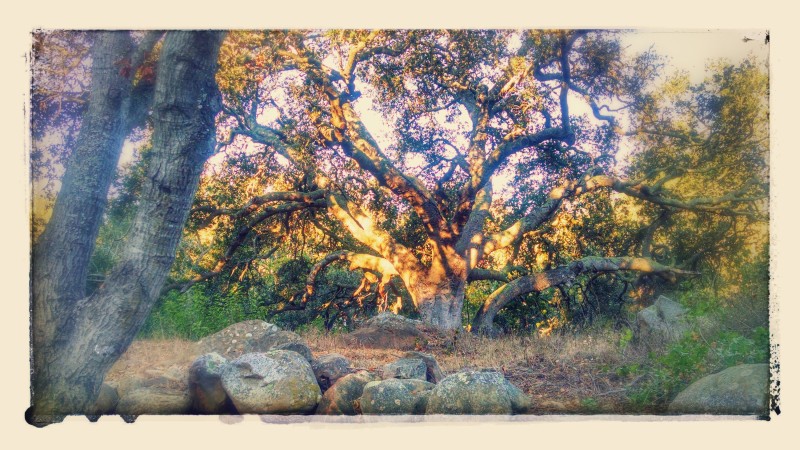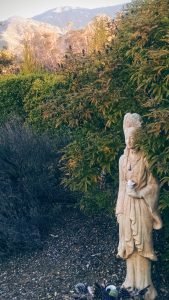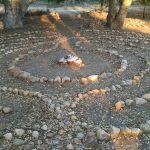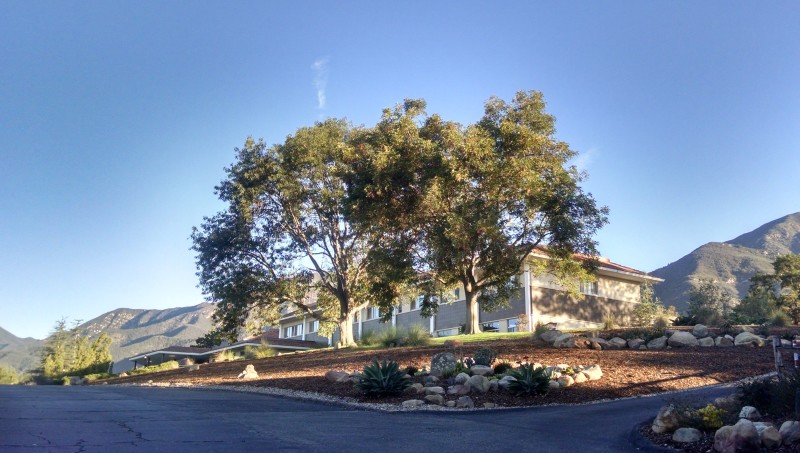 I spent the last couple of days of August at the Pacifica Graduate Institute in Santa Barbara, California attending “Sacred Encounters: Yoga, Meditation & Depth Psychology,” an inaugural program that brought together practicing psychotherapists, Pacifica faculty and yoga instructors (some of whom are also therapists and graduates of the Pacifica programs). I’ve been thinking about and exploring yoga as a psychological practice for many years now, and this was my first exposure to a community that through comparison and practice is weaving together some of the tenets and methodologies of Depth Psychology and Yoga Psychology.
I spent the last couple of days of August at the Pacifica Graduate Institute in Santa Barbara, California attending “Sacred Encounters: Yoga, Meditation & Depth Psychology,” an inaugural program that brought together practicing psychotherapists, Pacifica faculty and yoga instructors (some of whom are also therapists and graduates of the Pacifica programs). I’ve been thinking about and exploring yoga as a psychological practice for many years now, and this was my first exposure to a community that through comparison and practice is weaving together some of the tenets and methodologies of Depth Psychology and Yoga Psychology.
Depth Psychology – think Carl Jung, archetypes, dream analysis, symbols, even Joseph Campbell’s “Power of Myth” – is concerned with our unconscious and with employing psychoanalytic techniques that help bring our unconscious contents to consciousness. Through this work we become integrated, or in Jung’s terminology, “individuated.” Dream analysis, examination of our personal histories – our personal “narratives” or “myths” – are often the primary points of focus in the analytic relationship. In addition, many analysts will also employ creative therapy and bodywork as complementary modes of exploration when our rational, verbal, thinking mind hits a roadblock.
Similarly, we can pursue a greater degree of psychological awareness and wholeness through the practice of yoga, especially in our deeper meditation practice, where we are focusing the mind in order to peel away all of the ego “stuff” that gets in the way of seeing our true selves. If we apply Depth Psychology principles to meditation, we see how we can use meditation to explore the unconscious – the “stuff” we push out of the way: repressions, projections, our “shadow” tendencies (and in relationship with a skilled analyst, even past abuses and traumas).
You can see the full program and read about all of the presenters through the link above. Here’s a short recap and highlights of those presentations I was able to attend:
Dr. Patrick Mahaffey, Religious Studies Faculty at Pacifica, opened our Friday evening and delivered a beautiful, experiential presentation that tracked the several strands of Yogic discipline and their parallels in Depth Psychology. “The Heart of Yoga: Pathways to Freedom and Self-Realization” was a concise overview of the many contemplative or meditative yogic practices (Vedanta, Patanjali’s Yoga [“raja” or “ashtanga”], the Yoga of the Baghavad Gita, and Tantra). Mahaffey clearly explained the terminology and aims of each and their complement within the Jungian analytical framework. For example, if we understand idea of “complexes” in Depth Psychology (emotional centers around which personality and behavior patterns develop), we can see their parallel in the samskaras – almost genetically encoded psychological “impressions” we store unconsciously that manifest as the kleshas (ignorance, egotism, attachment, aversion, fear of death – our “causes of emotional and existential distress”). Similarly, we can deepen our understanding of the relationship of archetype or true self to ego by re-reading it as symbolized in the relationship and dialog between Krishna and Arjuna in the Baghavad Gita.
In his seminar on Kundalini Yoga, Jung cautioned against the full sale adoption of Yoga in the West, and for his time I think his reasoning was legitimate. Jung felt that Western culture would come to evolve its own Yogic system of self realization. Mahaffey thinks we’ve come far enough in our study and our practice to understand and experience the self-realization that a consistent, devoted meditative practice grounded in Eastern traditions and philosophy can offer us, with no ill effects. Still, he advocates a balanced understanding of our yoga practice using the tools of Depth Psychology.
 Ashley Turner is a yoga instructor and therapist and a graduate of the Pacifica program. Her illuminating talk entitled “The Chakra System: Intersection of Body, Psyche and Soul” I loved most for its assignation of a balanced archetype to each of the seven chakras: Root: Mother; Sacral: Emperor/Empress; Solar Plexus: Warrior; Heart: Lover; Throat: Messenger (i.e., Mercury/Apollo); Third Eye: Wise Woman/Wise Man; Crown: Guru/Seer.
Ashley Turner is a yoga instructor and therapist and a graduate of the Pacifica program. Her illuminating talk entitled “The Chakra System: Intersection of Body, Psyche and Soul” I loved most for its assignation of a balanced archetype to each of the seven chakras: Root: Mother; Sacral: Emperor/Empress; Solar Plexus: Warrior; Heart: Lover; Throat: Messenger (i.e., Mercury/Apollo); Third Eye: Wise Woman/Wise Man; Crown: Guru/Seer.
Also new to my understanding of the chakra system was an association of a specific food group (!) with each chakra: Root: Meats/proteins (survival, primal needs); Sacral: Liquids (movement, fluidity); Solar Plexus: Starches (to fuel the fire of the will); Heart: Vegetables (heart healthy); Throat: Fruits (healing for voice and throat); Third Eye: Enthoegens (aka naturally derived chemicals used in ritual, shamanic or spiritual contexts); Crown: Fasting. So, lots of new connections to share with students.
Ellen Criswell’s talk, “Somatic Yoga and the Self,” along with her yoga asana session was the highlight of the weekend for me. Born in 1938, Criswell is still at work as an instructor and a therapist. Her work and reputation in the field of Somatic Yoga are legendary. Her book, An Introduction to Somatic Yoga goes deep into the connections between the science of what is happening in the brain, nervous system and the body and the effects that our yoga and meditation practices have on those processes. Somatic Yoga is yoga therapy. I have written in my notebook in all caps: “I’M DOING THIS.” What did I mean? I think I meant both that I am already bringing somatic insight into my teaching and also that I want to do more of this, to learn more about this mode of practice and healing. This is a both a practice and therapeutic technique that according to Criswell is “somatics, neuroscience, applied psychophysiology and psychology, especially depth psychology.” The approach to asana or yoga postures: 1) is mindful and aware, employing visualization – imagining the sensation of the pose prior to execution, which sets up a motor plan in the brain; 2) is slow and gradual deepening and never more than the individual’s range of motion. Slow applies more importantly to coming out of a pose. 3) Savasana or corpse pose is employed throughout the practice for proprioceptive sensing and integration of the pose into the body/mind.
Tracking back to the practical application of Yoga philosophy in therapeutic practice, Rueben Weininger, a therapist in private  practice in Los Angeles gave a talk and yoga session entitled “The Integration of Yoga in Clinical Practice of Psychotherapy and Psychiatry.” Weininger likens the yoga student/yoga teacher relationship to that of the patient/therapist. Not many of us have the opportunity to study one-on-one in the traditional Yogic manner of disciple and guru. In the west, perhaps our analysts, our therapists (and in some circumstances, our yoga instructors) are our soul teachers. This is especially the case in Depth Psychology. Weininger’s point was not to create an elevated status for therapists, only to point out the necessary intimacy that is the foundation of both relationships. If our therapists have the tools to guide us to emotional health while helping to illuminate the soul, we have a sacred relationship.
practice in Los Angeles gave a talk and yoga session entitled “The Integration of Yoga in Clinical Practice of Psychotherapy and Psychiatry.” Weininger likens the yoga student/yoga teacher relationship to that of the patient/therapist. Not many of us have the opportunity to study one-on-one in the traditional Yogic manner of disciple and guru. In the west, perhaps our analysts, our therapists (and in some circumstances, our yoga instructors) are our soul teachers. This is especially the case in Depth Psychology. Weininger’s point was not to create an elevated status for therapists, only to point out the necessary intimacy that is the foundation of both relationships. If our therapists have the tools to guide us to emotional health while helping to illuminate the soul, we have a sacred relationship.
He went on to remind us of Yogic concepts therapists might already be using in their work with patients: avidya or “not seeing clearly” due to asmita/ego, raga/desire, dvesa/aversion, and abhiniveja/doubt. Or looking at ego consciousness from the point of view of Yoga psychology where purusa (seer) parallels the “pure” or “big” Self – behind – citta (mind) which is likened to the filter of ego or persona which consciously processes prakriti (matter), thought of as the “world” or subjective and objective realities. In addition, he uses the concept of the gunas to help diagnose “qualities of mind” seen in psychiatric practice. So in order to determine whether patients are primarily tamasic/heavy, or rajasic/agitated, he poses a series of questions: “How does the patient live? What are their samskaras or habits in terms of sleep, food, exercise, social life?” He then suggests the integration of specific breathing exercises (longer exhalation/ujjayi) to de-intensify emotional reactions; asana sequences primarily because they convey to the patient the experience of a different state of being than what they are used to; homework in the form of altering our passive intake habits, so reading classic literature or listening to calming music before bed rather than browsing the internet or watching television. In essence, the therapist needs to “see through to the healthy person as soon as possible” and offer practical tools for the patient to begin to see through to their own healthy person, too.
Aaron Kipnis closed the weekend for me (I missed the weekend’s “closing ritual”; I had to get on the PCH!) with his talk “All the Way Down: Depth Psychology, Quantum Mechanics and Yoga Philosophy.” His overview of the growth of east/west psychology as someone who witnessed and thought and wrote and taught about that development from the beginning was fascinating. I’m not much of a scientist – I have to repeatedly ask my husband to explain the difference between atomic and nuclear (are they different?!) and his books about quantum theory mostly fly right over my head – but I get the basic idea of energetic flux, and that our minds and bodies – indeed every living thing – are part of that flux and when you hear someone talk about how “we’re all one” (namaste), that’s what they mean; that there’s only particle and energy and one can be the other and the stability of one destabilizes the other and that dynamic is operational in each of us at every moment of our lives – and that we are each a unique, individualized expression of one particle/energy dynamic that culminates in discrete, material, physical bodies. Is that right?! If so, I get that.
The practice of Yoga is one way of remembering that and with discipline it is also a way to experience the state of flux. Kipnis explains that traditional psychotherapy and western psychologies can only take us so far if our goal is transcendence, or consciousness beyond thought. Yoga and to some extent Depth Psychology offer tools for the experience of higher levels of consciousness by allowing for the opportunity to see beyond that “first taste” (transcendence or awareness without thought). There isn’t space for me to go much beyond that here. But I did also like the Kipnis’ idea of a “Depth Psychological Field” as a “third place that is co-created in the patient-therapist relationship; they don’t come into yours and you don’t go into theirs.” It is a third, intersubjective field, and as such a quantum relationship.
My final take-away was a big “why did I have to go all the way California to get this?!” Though I’d return here, to one of the most beautiful places in the country every year should Pacifica continue to host Sacred Encounters. In the meantime, let me know if the the ideas of yoga and depth psychology speak to you in the ways they so clearly speak to me. I’d love for us to start to put something together right here. Reading lists, reading groups, more mythology in our yoga practice, you name it.
In friendship and love,
Shannon
